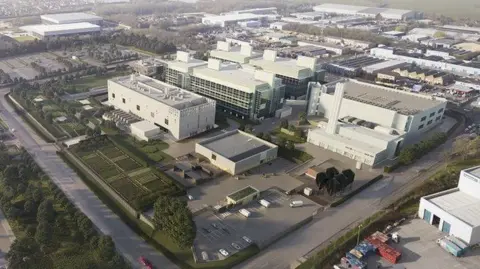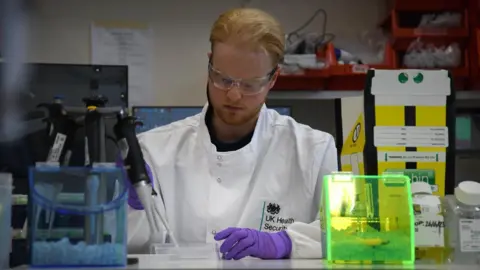Deadly pathogen research hub remains unbuilt despite £400m spend
 Public Health England
Public Health EnglandTucked away on an industrial estate in Essex is a building that could one day house some of the world's deadliest pathogens.
Hundreds of millions of pounds have been spent creating one of the UK's most secretive new research centres, but the project in Harlow has been in limbo since March 2023.
Initially expected to cost £530m and open in 2021, the government put the project on ice when that estimate skyrocketed to £3.2bn.
With uncertainty continuing to cloud what was once touted as a "big step forward for UK public science", the BBC takes a look at where it went wrong.
What was the plan?
The project was born out of concerns about the high-containment laboratories in Porton Down in Wiltshire, and Colindale in north London.
These sites are essential for detecting and studying the most dangerous pathogens, including Ebola and Covid-19.
But they are ageing, nearing the end of their operational lives and need replacing with facilities fit to prevent the next pandemic.

After years of deliberations, it was Harlow that was announced as the home for a new national integrated hub for public health science in 2015.
The town's Conservative MP at the time Robert Halfon celebrated it as a move that would create thousands of jobs.
To make it work, 900 workers would relocate from Wiltshire to Essex to begin the transition.
Yet the government body responsible for overseeing the project kept changing.
It was first mooted by the Health Protection Agency, which was superseded in 2013 by Public Health England (PHE), which then became the National Institute for Health Protection (NIHP) in 2020.
The project was rebranded the "science hub" programme when it fell at the door of the newly-created UK Health Security Agency in 2021, which replaced the NIHP.
All the while, the price kept creeping up and up.
How much has this cost?
The project was estimated to cost £530m when it was announced by the chancellor at the time, George Osborne, before being revised later that year to £888m.
A site owned by the pharmaceutical company GlaxoSmithKline, in west Harlow, was purchased by PHE for £30m to get the ball rolling in 2017.
Three business cases were drawn up for the development, but the government has never given any of them full approval.
The plot on the industrial estate is still made up of redundant, unused, offices.

More than £400m has been spent on the project to date, according to a National Audit Office (NAO) report, but no work has taken place since March 2023.
Despite this, the BBC can reveal between that date and February 2025, UKHSA has forked out an extra £3.3m on the dormant land.
That includes £1.1m on security, £1m on utility bills and £698,000 on maintenance, revealed under the Freedom of Information Act.
Today's cost of the whole project is estimated to be £3.2bn, a figure more than 500% higher than the initial forecast.
Speaking at a House of Commons public affairs committee in May 2024, Dame Meg Hillier said there had been "no accountability" for the increase.
What is going on now?
 PA Media
PA MediaNo construction work is taking place at the site, which is being maintained by staff to keep it secure.
The government has been considering options for its high-containment laboratories and whether building a new one is still viable.
It estimates if the Harlow centre is built, it will not open before 2036 - some 15 years late.
Eight civil servants are working on the project, but their hands are tied while they wait to hear if the government still wants to go ahead with it.
The NAO report said "doubts have emerged" about its viability within the Department of Health and Social Care.
It revealed DHSC ministers had asked UKHSA to consider if upgrading the existing sites in Porton Down and Colindale would be more cost-effective.
A UKHSA spokesman said staff were "hoping for a decision in the coming months".
The issue was last raised in Parliament in March, when Health Secretary Wes Streeting was asked about the delays.
"[This] has been running around the system so long that it is now used in a case study for senior civil servant recruitment," he said.
"The worst decision is indecision.
"It has plagued us for too long and I hope we can soon report back to the house with a decision on that for everyone's benefit."
Follow Essex news on BBC Sounds, Facebook, Instagram and X.
